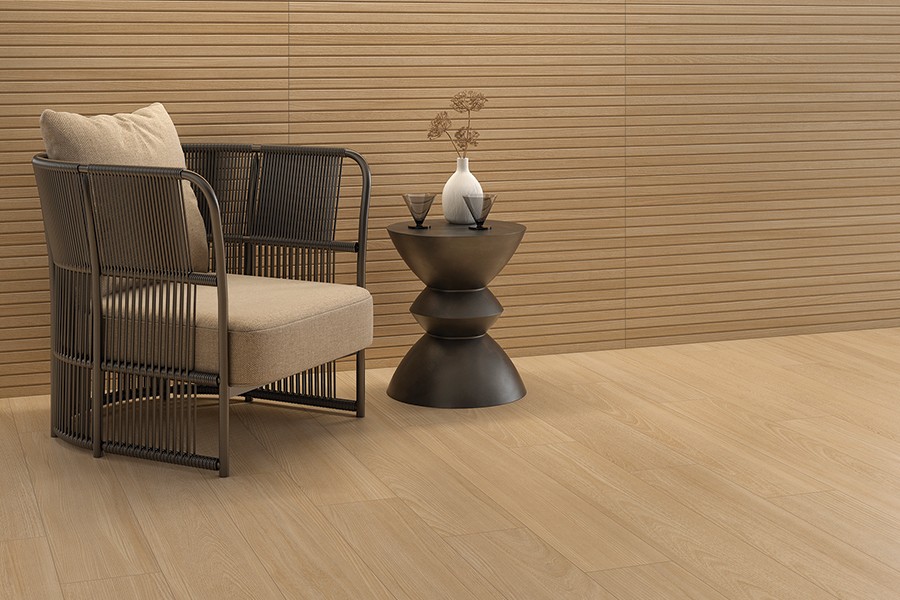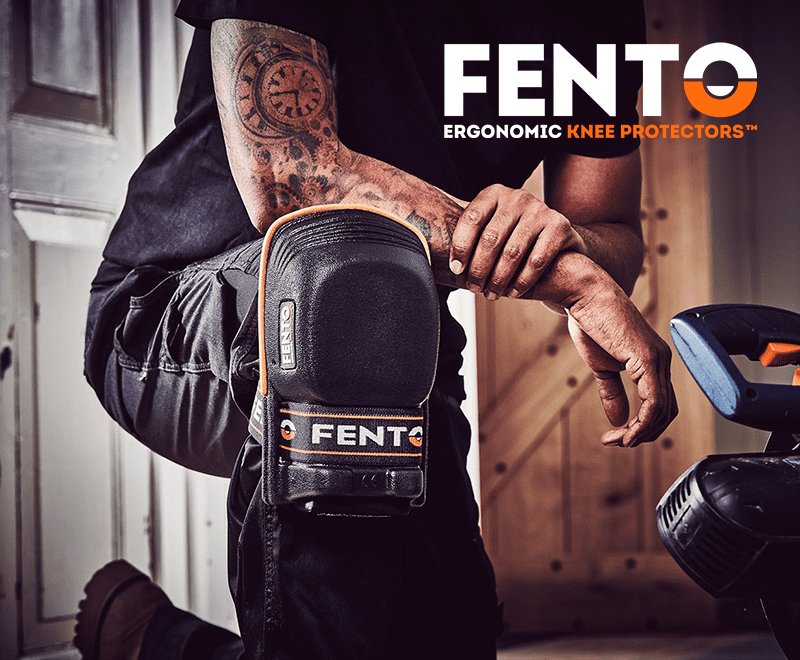While the natural expectation for a trade show entering its 40th year might be for creativity to begin dwindling and nostalgia to take precedent, this year’s Cevisama instead saw exhibitors look intently towards the horizon, selecting a few striking new visual trends and iterating on them relentlessly.
With history and tradition forming such an important part of the sector’s continued appeal (indeed, reference to that historical legacy remained a powerful tool for designers at this year’s show) it’s unreasonable to ever expect wholesale reinvention from the ceramics industry. That said, there was an undeniably modern, propulsive quality to many of the manufacturers’ presentations, representing a sense of both excitement and urgency.
Of course, underlying that urgency is the fact that 2023 was a very difficult year – for the industry at large but particularly for European manufacturers who, after emerging from the pandemic years to post record revenues in 2022, now found themselves saddled with ballooning production costs and contracting demand. At last year’s Cersaie exhibition in Bologna, we saw manufacturers’ first line of response to this challenge: a deliberate reigning in of design sensibilities to focus on tried-and-true classics. Here at Valencia, exhibitors appeared just as focused, but more confident to stake out and commit to new ideas and trends.
Natural effects, including near endless recreations of wood and stone, still occupied a huge proportion of the show floor, however even these saw huge variation in relief, texture and dimension. Beyond those more standard options, designers mixed and matched between a relatively limited but distinctive set of visual motifs, highlighting the chameleonic ability of ceramics to slot into and enhance any interior or exterior space. Particularly notable at this year’s exhibition was the way trends synergised, with colour palettes and visual effects mixed-and-matched across a variety of popular tile shapes and dimensions. As such, while the total number of truly novel impulses at the exhibition was lower than some previous editions, the diversity of products on display remained as impressive as ever.
Over the past year, the industry has been compelled to display incredible tenacity and resilience just to survive through some extraordinary market conditions. As 2024 hopefully begins to see some of those conditions normalise, those same qualities are sure to see ceramic and porcelain manufacturers thrive. Encouragingly then, Cevisama’s 40th edition functioned less as a predictable retread of bygone times and more as a fresh start for an industry all too ready to rebound.
Setting the stage
Just as last year, the show’s press conference provided a somewhat frank assessment of the external challenges facing the Spanish tile industry, and once again, Vicente Nomdedeu, president of ASCER (the Spanish Ceramic Tile Manufacturers’ Association) explained what the organisation believes should be done.
At a high level, while the Spanish industry is still producing a top-quality product, Nomdedeu said, the contraction of domestic demand and the rapid growth of non-EU producers like India and China have had a significant impact on the company’s position in the global market. This state of affairs is made even more difficult by the fact that, in comparison to non-EU producers, Spanish manufacturers must adhere to strict environmental and labour policies, inevitably raising the price of its end product.
In ASCER’s view then, there are a few things that must change to improve the sector’s results, and the first (much like last year) is an increase in support from the government. Nomdedeu described the response from the national government as “very insufficient” and explained how it is vital for the state to help its tile industry maintain a competitive position in the global market. One area of he particularly highlighted as a potential area for investment was training. In the organisation’s view, training is vital for the industry to continue innovating, and innovation is the most consistent route to success.
Clearly, there are still many challenges ahead for the industry, and so it was encouraging to see the densely packed show floor, hear snippets of productive conversation and – above all – observe the industry’s latest work.
Planks and panels
The most obvious and confidently expressed trend across this year’s exhibition was the thin plank format. Seemingly every manufacturer tried their hand at this style, to the extent that even other trends – of colour, relief and finish – were mostly found on this shape of tile.
Some particularly striking examples of this trend included Equipe’s Vitral range, available in a 5x40cm format and 12 colours, eight of which are described as soft with the remaining four providing “bold” accompaniment. According to the manufacturer, the collection “adds style and elegance to interior design with its elongated shape and gloss finish”.
Natucer’s Cotto Brick collection provides a similar, if slightly more rustic, effect in a floor tile. This range taps into another of the most popular choices at this year’s exhibition, which is the roasted orange colour of its namesake. Available in a 7x60cm format and four neutral colours, the tile creates an even more exaggerated shape, although its convincingly natural finish allows it to blend into the background if necessary.
Of course, the classic material for long planks has always been wood, and with advancements made in texture and resolution, ceramics manufacturers are now able to recreate this material more realistically than ever before. The Poeme range from Keraben is a perfect example of this capability, evoking the “beauty and warmth of this original material” with authentic wood grains and colours. Presented in a larger but still skinny format of 20x120cm, the Poeme range represents a sub-trend of using surface relief to create the illusion of even thinner individual tiles or even wall panelling.
Luxury and simplicity
Two seemingly opposed trends coexisted comfortably at this year’s Cevisama – with rustic, unassuming designs displayed right alongside examples of luxury and opulence. On the more subtle end of the spectrum were ranges like Focus from Apavisa, which is available in three large format shapes (50x100cm, 60x60cm and 100x100cm) and takes terracotta and stone as its aesthetic inspirations. Although this collection includes several variations in pattern and texture, the naturalistic, muted colour palette ensures it always remains “fine and delicate,” the manufacturer says.
Also among these more humble offerings was Ibero’s Lune collection (also happening to feature a plank relief variant!) a range of mid- to large-format stone effect tiles which employ the “timeless aesthetics of slate”. One of the primary strengths of these designs is their suitability for a wide variety of applications – indeed, Ibero describes this range as “perfect for adapting to all kinds of spaces”.
Many exhibitors were also out to make a statement, however, sometimes on the same stand! Metropol (like Ibero, part of the Keraben Group) focused heavily on these eye-catching designs, with its marble-effect Charisma range proving particularly impressive. “Synonymous with style and sophistication,” the manufacturer says, these tiles accurately capture both the visual and tactile experience of marble through a range of colours and textures.
Perhaps more luxurious still, Arcana’s Les Bijoux range aims to exceed even nature, with the manufacturer claiming to “[enhance] the excellence of marble”. This high gloss collection provides designers with easy and consistent access to both shades and finishes that would be difficult if not impossible to find in its natural counterparts. The range’s attention-grabbing Doinyo variant, for example, is a “pearl-based porcelain marble with light blue and gold waves in sinuous and enveloping shapes”.
Shapes and patterns
Speaking of shapes, another major theme at this year’s show was the prevalence of small formats in a huge variety of different shapes, from hexagons to fish scales to even more complex cuts. As always, Decocer was a major standard-bearer in this realm, with its Areka range suggesting subtle visual intrigue in the form of randomly dotted darker shades on a plainer grey, or its Harmony collection offering a splash of bright colour on a kitchen splashback.
Described as a “daring ceramic project” the Cuore collection from Natucer pushes this trend further still, with an explosion of different textures, formats and shapes available, from elongated diamonds to wide fish scales and interlocking stars and crosses.
Similar to this playfulness in the use of shape was exhibitors’ exploration of patterns. The Tessela range from Gayafores, for example, features an enormous array of whimsical patterns constructed from mosaic building blocks. In another example of cross-pollination between two trends Toko (once again from Apavisa) is designed to evoke “quiet luxury” with its intricate and detailed geometric effect.
Beige and beyond
Although this trend may sound a little drab, the colour palette of most of this year’s tiles felt more traditional than it did boring. While there is undeniably still some reticence to explore the outer extremities of the colour wheel, the absolute sea of beige which greeted visitors at last year’s Cersaie exhibition has been expanded to a complementary but sensible set of earthy, comforting tones.
This means that, in addition to the examples showcased throughout all of the previous trends, we also saw soft greens (such as in Vives’ Zero collection) as well as dark blues and many depths of cotto shades. Keraben’s Terracota range, for example, combined the eponymous colour with a series of different accents.
Although this is a rather tentative step, the addition of more colour variations on top of the beige baseline indicates manufacturers are beginning to feel renewed confidence in what customers will be actively seeking in 2024. Taking a broader view, the consistency of all the above themes at Cevisama 2024 is a strong sign of confidence in where the market is headed over the next 12 months – and we should all hope that confidence is well-founded.
After all, whether you’re a distributor, a retailer or a fixer, it all begins with the tiles themselves. Fortunately, this is an industry with a long history of both predicting and indeed shaping trends – and this year’s exhibitors showed every sign it will continue to do so.
www.cevisama.feriavalencia.com








